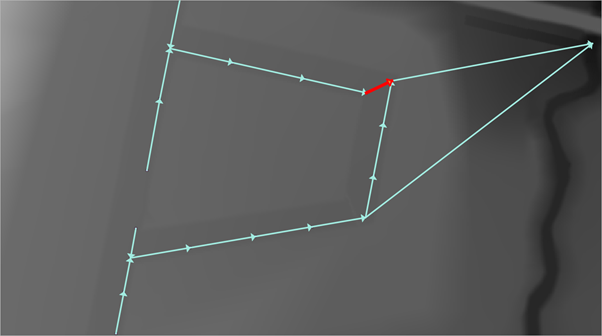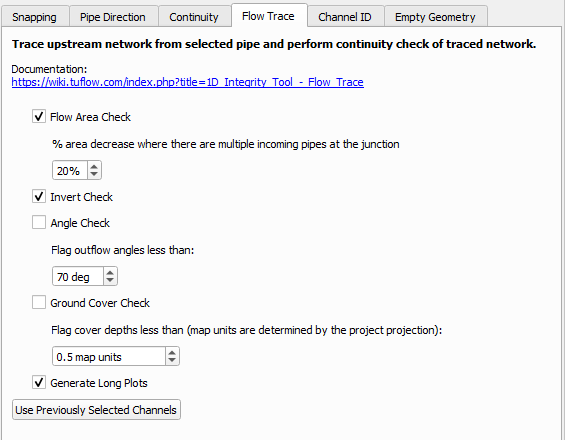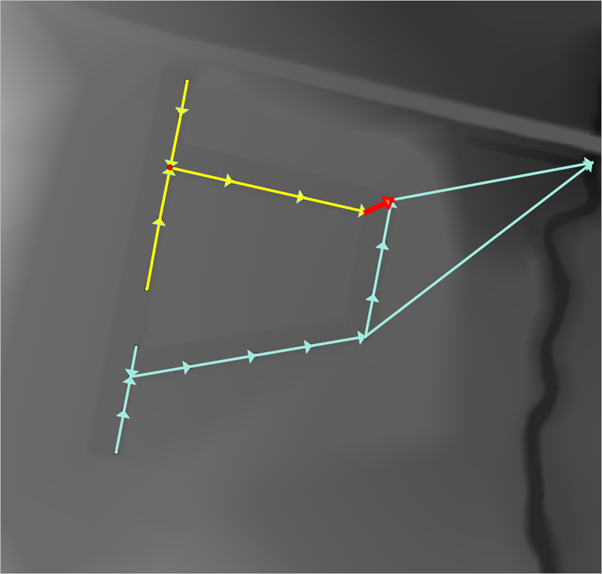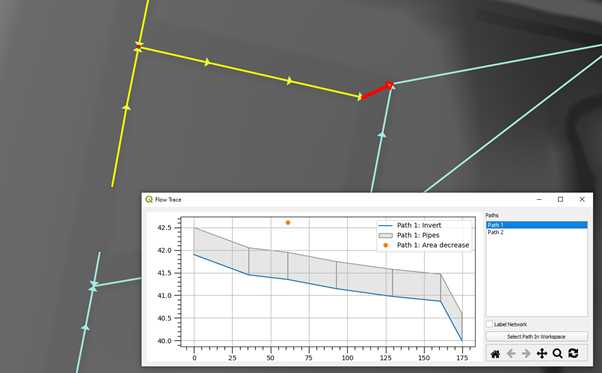Integrity Tool - Flow Trace Tool: Difference between revisions
Jump to navigation
Jump to search
Content deleted Content added
Tuflowduncan (talk | contribs) No edit summary |
Ellis Symons (talk | contribs) No edit summary |
||
| (2 intermediate revisions by one other user not shown) | |||
| Line 1: | Line 1: | ||
The [[1D_Integrity_Tool_-_Flow_Trace|Flow Trace]] tool creates traces upstream from the selected channel, selecting all upstream network objects in the QGIS map window (network lines and network points). |
The '''<u>[[1D_Integrity_Tool_-_Flow_Trace|Flow Trace]]</u>''' tool creates traces upstream from the selected channel, selecting all upstream network objects in the QGIS map window (network lines and network points). |
||
<ol> |
<ol> |
||
| Line 6: | Line 6: | ||
[[File:Pipe15.png]] |
[[File:Pipe15.png]] |
||
<li> Ensure that '''1d_nwk_MI01_Pipes_001_L_EG1_ID1_SN1_PD1''' is referenced in the 1D network Line Layers and select the Flow Trace tab. |
<li> Ensure that '''1d_nwk_MI01_Pipes_001_L_EG1_ID1_SN1_PD1''' is referenced in the 1D network Line Layers and select the '''Flow Trace''' tab. |
||
<li> Select to undertake the Flow Area and the Invert Checks. |
<li> Select the relevant option to undertake the '''Flow Area''' and the '''Invert Checks'''. |
||
<li> Also ensure the ‘Generate Long plots’ option is selected.<br> |
<li> Also ensure the '''‘Generate Long plots’''' option is selected.<br> |
||
[[File:Flow trace.png]]<br> |
[[File:Flow trace.png]]<br> |
||
| Line 33: | Line 33: | ||
[[File:Flow trace output.png]]<br> |
[[File:Flow trace output.png]]<br> |
||
A Flow Trace window is also provided which provides long sections or the various upstream paths from the selected link, highlighting areas of continuity failures. The individual paths can be assessed individually and |
A Flow Trace window is also provided which provides long sections or the various upstream paths from the selected link, highlighting areas of continuity failures. The individual paths can be assessed individually and identified within the QGIS canvas.<br> |
||
[[File:Flow trace canvas.png]]<br> |
[[File:Flow trace canvas.png]]<br> |
||
| Line 42: | Line 42: | ||
</ol> |
</ol> |
||
Please return to the |
Please return to the '''<u>[[1D_Integrity_Tool_-_Tutorial#Using_the_1D_Integrity_Tool|1D Integrity tutorial page]]</u>''' to continue the tutorial. |
||
Latest revision as of 23:47, 8 April 2022
The Flow Trace tool creates traces upstream from the selected channel, selecting all upstream network objects in the QGIS map window (network lines and network points).
- Find and select link Pipe15.

- Ensure that 1d_nwk_MI01_Pipes_001_L_EG1_ID1_SN1_PD1 is referenced in the 1D network Line Layers and select the Flow Trace tab.
- Select the relevant option to undertake the Flow Area and the Invert Checks.
- Also ensure the ‘Generate Long plots’ option is selected.

Table 1 describes the various Checks that can be conducted.
Table 1: Flow Trace ChecksCheck Description Flow Area Check Identifies location where the downstream flow are decreases Invert Check Identifies location where pipes have either an adverse gradient or where the outgoing pipe invert level is higher than the incoming pipe invert. Angle Check Identify locations where the angle between incoming and outgoing pipe is less than a given input angle (180 degrees is straight) Ground Cover Check Identifies locations where the distance between the pipe suffix and the ground elevation (taken from an in input DTM) is less than specified - Run the Flow Trace. This will select all the upstream links and also add another output layer identifying the locations which fail the flow area and invert checks.

A Flow Trace window is also provided which provides long sections or the various upstream paths from the selected link, highlighting areas of continuity failures. The individual paths can be assessed individually and identified within the QGIS canvas.

To find out more about the options in the Flow Trace Canvas see this page.
In this instance the identified issues would have to manually adjusted if appropriate, no automatic fixes are available.
Please return to the 1D Integrity tutorial page to continue the tutorial.